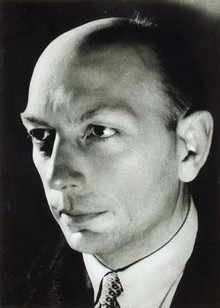Henri Michaux
Henri Michaux | |
|---|---|
 | |
| Born | 24 May 1899 Namur, Belgium |
| Died | 19 October 1984 (aged 85) Paris, France |
| Occupation | Poet, journalist and painter. |
| Genre | Surrealism, fantastic style, asemic writing |
| Notable works | My Properties (1929); Plume (1938); Miserable Miracle: Mescaline (1956). |
Henri Michaux (French: [miʃo]; 24 May 1899 – 19 October 1984) was a highly idiosyncratic Belgian-born poet, writer, and painter who wrote in French. He later took French citizenship. Michaux is best known for his esoteric novels and poems written in an accessible yet erratic and unnerving style.[contradictory] His body of work includes poetry, travelogues, and art criticism. Michaux travelled widely, tried his hand at several careers, and experimented with psychedelic drugs, especially LSD and mescaline,[1] which resulted in two of his most intriguing works, Miserable Miracle and The Major Ordeals of the Mind and the Countless Minor Ones.
Travels and work[]
This section does not cite any sources. (October 2018) |
In 1930–1931, Michaux visited Japan, China and India. The result of this trip is the book A Barbarian in Asia.[2][3][4] Asian culture became one of his biggest influences. The philosophy of Buddhism and calligraphy later became principal subjects of many of his poems and inspired many of his drawings.
He also traveled to Africa and to the American continent, where he visited Ecuador and published the book Ecuador.[5] His travels across the Americas finished in Brazil in 1939, and he stayed there for two years.
Michaux is best known for his stories about Plume – "a peaceful man" – perhaps the most unenterprising hero in the history of literature, and his many misfortunes. Michaux's writing is known for its strangeness and originality. As his translator, David Ball, puts it in Darkness Moves (the most comprehensive Michaux anthology in English), Michaux's poems are "messages from his inner space." That space may be transformed by drugs as in Miserable Miracle or by terrifying visions, as in "Space of the Shadows" but the "messages" from it are always expressed as clearly and concretely as possible.
Michaux was also a highly original artist, associated with the Tachiste movement in the 1940s and 50s. His work often makes use of dense, suggestively gestural strokes that incorporates elements of calligraphy, asemic writing, and abstract expressionism. The Museum of Modern Art in Paris and the Guggenheim Museum in New York both had major shows of his work in 1978.
In 1955 he became a citizen of France,[6] and he lived the rest of his life there along with his family. In 1965 he won the grand prix national des Lettres, which he refused to accept.
See also[]
Bibliography[]
- Ball, David (ed.): Darkness Moves: An Henri Michaux Anthology 1927–1984, Translated, Selected and Presented by David Ball. University of California Press, 1994.
- Bäckström, Per. Enhet i mångfalden. Henri Michaux och det groteska (Unity in the Plenitude. Henri Michaux and the Grotesque), Lund: Ellerström, 2005.
- Bäckström, Per. Le Grotesque dans l’œuvre d’Henri Michaux. Qui cache son fou, meurt sans voix, Paris: L’Harmattan, 2007.
- Bowie, Malcolm. Henri Michaux: A Study of his Literary Works. Oxford: Clarendon Press, 1973.
- C L Campos, "Michaux, Henri" in Anthony Thorlby (ed). The Penguin Companion to Literature. Penguin Books. 1969. Volume 2 (European Literature). Page 534.
- Conoley, Gillian (translator). Thousand Times Broken: Three Books. City Lights, 2014.
- Ellmann, Richard (translator). Selected writings: The space within. New York: New Directions, 1968.
- Landes Levi, Louise (translator). Vers La Completude. Le Tirlemont, Amsterdam 1983.
- Landes-Levi, Louise. Toward Totality: Selected Works, 1929–1973. Shivastan, 2006.
- Landes-Levi, Louise. Yantra – As insert to Tantra Song. Siglio, 2011.
- Müller-Yao, Marguerite Hui. Der Einfluß der Kunst der chinesischen Kalligraphie auf die westliche informelle Malerei, Diss. Bonn, Köln 1985. ISBN 3-88375-051-4
- Müller-Yao, Marguerite. "Informelle Malerei und chinesische Kalligrafie", in: Informel, Begegnung und Wandel. (hrsg von Heinz Althöfer, Schriftenreihe des Museums am Ostwall; Bd. 2), Dortmund 2002. ISBN 3-611-01062-6.
- Sieburth, Richard (translator). A Certain Plume. New York Review Books, 2018.
- Wedewer, Rolf. Die Malerei des Informel. Weltverlust und Ich-Behauptung, Deutscher Kunstverlag, München, 2007. ISBN 3-422-06560-1.
References[]
- ^ Paz, Octavio (9 August 2002). "Journeys into the Abyss". The Guardian.
- ^ [1] "A Barbarian in Asia". Retrieved 26 February 2019.
- ^ [2] "A Barbarian in Asia". Retrieved 26 February 2019.
- ^ [3] "The World of Michaux". Retrieved 26 February 2019.
- ^ [4] "Ecuador". Retrieved 26 February 2019.
- ^ [5] "Henri Michaux, French painter and poet".
External links[]
| Wikiquote has quotations related to: Henri Michaux |
- Petri Liukkonen. "Henri Michaux". Books and Writers
- Reelyredd's Poetry Pages, French text of Michaux poem "Ma Vie" with English translation
- Major paintings of Henri Michaux
- Thousand Times Broken: Three Books by Henri Michaux at City Lights Publishers
- Art Informel and Tachisme painters
- 1899 births
- 1984 deaths
- Belgian painters
- Belgian poets in French
- French fantasy writers
- Modern painters
- People from Namur (city)
- Belgian emigrants to France
- Naturalized citizens of France
- French male poets
- 20th-century French poets
- 20th-century French male writers